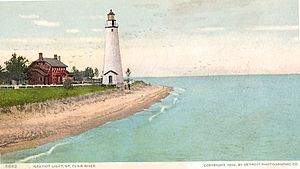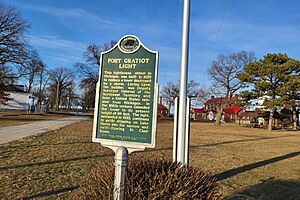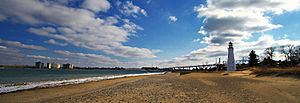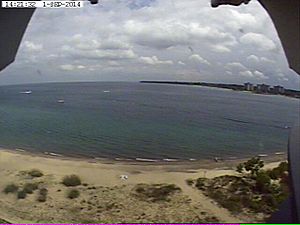Fort Gratiot Light facts for kids
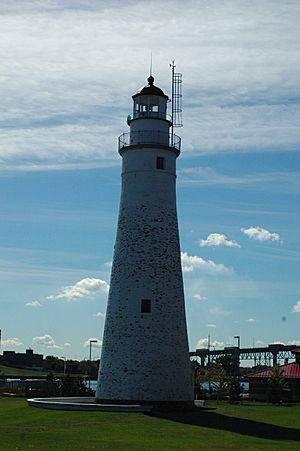 |
|
| Location | Omar and Garfield Sts., Port Huron, Michigan |
|---|---|
| Coordinates | 43°0′22.7″N 82°25′20.9″W / 43.006306°N 82.422472°W |
| Year first constructed | 1825 |
| Year first lit | 1825 |
| Automated | 1933 |
| Foundation | Dressed stone and timber |
| Construction | Brick |
| Tower shape | Frustum of a cone attached to workroom |
| Markings / pattern | White |
| Height | 85 feet (26 m) |
| Focal height | 82 feet (25 m) |
| Original lens | Fourth-order Fresnel lens (original), DCB-224 Carlisle & Finch Aerobeacon (current) |
| Range | 18 nautical miles (33 km; 21 mi) |
| Characteristic | Fl green 6 seconds |
| Fog signal | Station will give available information on fog conditions in upper river by radiotelephone when requested, (156.80 MHz). Standby light of reduced intensity lighted throughout 24 hours. |
The Fort Gratiot Light is a very important lighthouse. It was the first lighthouse ever built in the state of Michigan. It was built in 1825 by Lucius Lyon, who later became a U.S. Senator for Michigan.
This lighthouse stands at the entrance to the St. Clair River from Lake Huron. It helps guide ships safely into the river. The Fort Gratiot Light is still working today! The land around it is used by the Coast Guard, but the lighthouse itself is now managed by the Port Huron Museum. It is the oldest lighthouse in Michigan that is still standing. There is also a public beach and park nearby called Lighthouse Beach.
The lighthouse is located across the river from the Point Edward Front Range Light.
Contents
History of the Fort Gratiot Light
After the Erie Canal was finished, many more ships started traveling on the Great Lakes. This meant more coal from Michigan and more timber from Wisconsin were being moved. The entrance to the St. Clair River became a very busy spot. In 1823, the government decided to build a lighthouse there. They set aside $3,500 for the project.
A man named Captain Winslow Lewis was chosen to build the lighthouse. He was known for inventing a special lamp called the Lewis lamp. This lamp was used in many lighthouses across the country. Captain Lewis hired Daniel Warren to actually build the Fort Gratiot Light. The project cost more than expected, so more money was approved in 1825.
The first lighthouse tower was about 32 feet (9.8 m) tall.
However, this first lighthouse was not built very well. The first lighthouse keeper, George McDougall, reported problems. He said the stairs were so steep he had to climb them sideways! The opening to the light room was also very small. In 1828, a storm damaged the tower, and it later fell down.
The government quickly approved $8,000 for a new tower in 1829. This new tower was much taller, at 65 feet (20 m). It was also wider, about 25 feet across. It still used the Lewis lamp system, which burned whale oil.
Upgrades and Improvements
In 1852, a new group called the US Lighthouse Board was formed. They realized that the French Fresnel lenses were much better than the Lewis lamps. So, in 1857, the Lewis lamps were removed from Fort Gratiot. A new, brighter fourth-order Fresnel lens was installed. This new lens was at least four times brighter than the old lamps!
In 1874, a brick house was built for the lighthouse keepers. It was a duplex, meaning two families could live there.
As shipping on the lakes continued to grow, the lighthouse needed more improvements. In 1862, the tower was made even taller, reaching 82 feet (25 m). The fourth-order Fresnel lens was replaced with an even larger third-order lens. This new lens showed a steady white light. The old fourth-order lens was moved to the Saginaw River Lighthouse.
A building for the fog signal was added in 1900. This signal would help ships find their way in foggy weather. In 1932, a Coast Guard facility was built next to the lighthouse. The lighthouse and Coast Guard operations officially joined together in 1939.
Today, the lighthouse uses a modern light called a DCB-224 aero beacon. It was made by the Carlisle & Finch Company. The Fort Gratiot Light is the oldest lighthouse in Michigan that is still actively helping ships.
Fort Gratiot Light Today
The Fort Gratiot Light is recognized as an important historical site. It is listed on the National Historic Register. In 1971, the Michigan Historical Commission also named it a historic site.
In 2004, the Port Huron U.S. Coast Guard station moved into a new building right next to the lighthouse.
The United States Coast Guard stopped allowing visitors into the lighthouse tower in August 2008. This was because the brickwork was getting old and pieces were falling off. Experts said it would cost almost $4 million to fully fix it. In 2009, the city council decided not to take over the lighthouse because of the high costs. However, the St. Clair County Parks and Recreation department took charge of the lighthouse and its grounds in September 2010. They started offering guided tours of the lighthouse again in the summer of 2012.
Visiting the Lighthouse
The park around the lighthouse is open every day from 7:00 AM to 10:00 PM. It is free to enter the park grounds. If you want to take a tour of the lighthouse station and tower, you can buy tickets at the gift shop. The park is located at 2800 Omar Street in Port Huron.
When the main grounds are closed, there is a city park just north of the lighthouse. From this park's beach, you can get a great view of the lighthouse. If you are driving from Canada to Port Huron over the Blue Water Bridge, you can see the lighthouse on your right side.
See also


